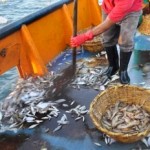
Los Baños, Philippines – The black boxes containing 42,627 samples of rice seeds traveled from International Rice Research Institute (IRRI) to the mountains of the Norwegian archipelago of Svalbard, about 1,200 kilometers from the North Pole. Deep inside Svalbard’s icy mountains, the Svalbard Global Seed Vault (or the “Doomsday Vault”) houses all of the world’s important crop seeds that may be humanity’s ultimate insurance in food security in the event of a major regional or global crisis.
The rice collection that left IRRI is the Institute’s second deposit to the Vault. The first deposit of 70,180 rice samples was made during the inauguration of the Vault in February 2008 – the largest shipment for the Vault’s opening.
“After this second deposit, IRRI now has the largest number of samples of a single crop and its wild relatives, coming from the largest number of countries, stored in Svalbard,” said Dr. Ruaraidh Sackville Hamilton, Head of IRRI’s International Rice Genebank (IRG).
If ideal conditions of temperature and storage are followed inside the Vault, seeds can be stored for hundreds of years.
The samples sent to Norway are duplicates of rice conserved at IRRI’s IRG in Los Baños, in the Philippines, that houses the largest collection of rice genetic diversity in the world. About 110,000 different types of rice are kept in long-term storage, the “base” collection, and in medium-term storage for distribution, the “active” collection.

“IRRI shares seed from the IRG for free with farmers, farmers’ groups, governments, universities, and others under conditions set by the International Treaty on Plant Genetics Resources for Food and Agriculture,” Dr. Sackville Hamilton explained. “One hundred twenty-six countries signed this Treaty that ensures the fair sharing of benefits from the use of these resources.”
IRRI, which celebrates its 50th anniversary this year, built the IRG in 1965. Its comprehensive rice collection includes samples of wild rice, ancestors of rice, traditional and heirloom varieties, and modern varieties. The fore-sight that drove its establishment is best demonstrated through IRRI’s work with national research institutions in characterizing traits that benefit rice breeding and developing improved rice varieties that address current and future challenges rice farmers face in their fields.
IRRI also works with governments in replenishing lost rice varieties. “IRRI’s collection of Cambodia’s native varieties proved critical after the Khmer Rouge strife that caused local rice varieties to vanish,” recalled Ms. Flora de Guzman, IRRI’s Research Manager at the IRG. “IRRI had duplicates of these varieties and so, between 1981 and 1989, IRRI and Cambodia completed the process of replenishing the country’s lost rice.”
The importance of preserving genetic diversity is in the spotlight this year as the world celebrates the International Year of Biodiversity that promotes awareness and appreciation of the world’s ecological and agricultural diversity.
Conserving rice diversity – or any crop diversity – is essential in helping the world face new environmental challenges and a changing climate. The genetic diversity of one type of rice from one part of the world may contain traits that allow threats, such as flooding, to be addressed in another part.
Although IRRI’s IRG has its own safety mechanisms in place to properly conserve its precious collection of rice genetic diversity, the duplicate samples sent to the Svalbard Global Seed Vault provide an ultimate back-up for its collection of rice genetic diversity.
Any contributing party can store seeds in the Vault for free.

About IRRI
Based in the Philippines, the International Rice Research Institute (IRRI) is the oldest and largest international agricultural research institute in Asia. It is an autonomous, non-profit rice research and education organization with staff based in 14 countries in Asia and Africa.
IRRI was established in 1960 by the Ford and Rockefeller Foundations in cooperation with the Philippine Government. Their mission is to reduce poverty and hunger, improve the health of rice farmers and consumers, and ensure that rice production is environmentally sustainable. They work closely with most rice-producing and -consuming countries and their national agricultural research and extension systems as well as farming communities and a range of international, regional, and local organizations. For more information, visit http://irri.org.
Source: IRRI.













